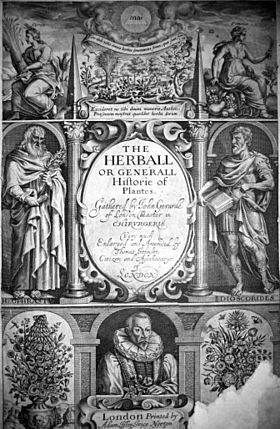Thomas Johnson (botanist) facts for kids
Quick facts for kids
Thomas Johnson
|
|
|---|---|

Title page of Johnson's 1633 edition of Gerard's Herball
|
|
| Born | 1595–1600 Selby, Yorkshire, England |
| Died | 1644 Hampshire |
| Occupation | apothecary, botanist |
| Nationality | English |
| Notable works | John Gerard's Herball, expanded |
Thomas Johnson (who died in 1644) was an English botanist, someone who studies plants. He was also a soldier, serving as a colonel for the King's side (called Royalists) during the English Civil War. Many people call him the "father of British field botany" because he was so important in studying plants in their natural outdoor settings.
Contents
The Life of Thomas Johnson
Thomas Johnson was born in Selby, a town in Yorkshire, England. He was born sometime between the years 1595 and 1600. It seems he received a good education. By 1626, he had become an apothecary in London. An apothecary was like a pharmacist or chemist who prepared and sold medicines.
Early Career in London
Around 1629, Johnson had his own business on Snow Hill in London. He even had a special "physic-garden" there. This was a garden where he grew plants used for medicine. He became a very important member of the Apothecaries' Company, a group for apothecaries.
Johnson's Role in the English Civil War
When the English Civil War began, Thomas Johnson joined the Royalists. These were the people who supported King Charles I. Because of his knowledge and his loyalty, he received special degrees from the University of Oxford. He became a Bachelor of Medicine in 1642 and then a Doctor of Medicine in 1643.
Johnson was also an active soldier. He helped defend Basing House, a very important Royalist stronghold. He became a lieutenant-colonel under the governor, Sir Marmaduke Rawdon. Sadly, on September 14, 1644, during a fight, he was shot in the shoulder. He got a fever from the injury and died about two weeks later.
Thomas Johnson's Important Work
Thomas Johnson created many important works about plants. His first work was a short report about a plant-finding trip. The Apothecaries' Company often went on these trips to study plants.
Early Plant Catalogues
His first plant report was called "Iter Plantarum Investigationis ergo susceptum a decem Sociis in Agrum Cantianum, anno Dom. 1629, Julii 13." This was published in London in 1629. It was the very first local list of plants ever published in England. He also added a small section about plants found on Hampstead Heath.
Johnson had visited Kent in 1626 and returned to both Kent and Hampstead Heath later. In 1632, he published a bigger version of both plant lists. He named the plants using the systems of other famous botanists like Lobel, Dodoens, and Gerard. He was inspired by early plant explorers like Ulisse Aldrovandi.
Expanding Gerard's Herball
In 1633, Johnson published his most famous work. It was called The Herball, … gathered by John Gerarde, … very much enlarged and amended by Thomas Johnson, citizen and apothecary of London. This book was a huge update to an earlier plant book by John Gerard from 1597.
Botany, the study of plants, had grown a lot in 36 years. Johnson added over 800 new plant types to the list. He also included 700 new pictures and made many corrections. The book had about 2,850 plant descriptions in total. People often called it "Gerard emaculatus," which means "Gerard cleaned up." Johnson finished this huge project in just one year! It was printed again in 1636 without changes.
Other Botanical Journeys
In 1634, Johnson published Mercurius Botanicus. This book described a twelve-day trip he took to places like Oxford, Bath, Bristol, Southampton, and the Isle of Wight. It listed the plants he saw with both English and Latin names. He also added a section about the baths in Bath.
In 1641, he released a second part, Mercurii Bot. pars altera. This part described a trip to Wales and Snowdon. On this trip, he found many new types of plants. In 1643, he also translated a book about surgery by Ambroise Paré from French into English.
Thomas Johnson's Legacy
Many people respected Thomas Johnson. A historian named Wood said he was "the best herbalist of his age in England." He also said Johnson was "no less eminent in the garrison for his valour and conduct as a soldier." This means he was just as good a soldier as he was a plant expert.
Johnson's smaller plant books became very rare over time. In 1847, T. S. Ralph collected and published all of them together. The book was called Opuscula omnia botanica Thomæ Johnsoni. Today, a group of plants called Johnsonia is named after him.

